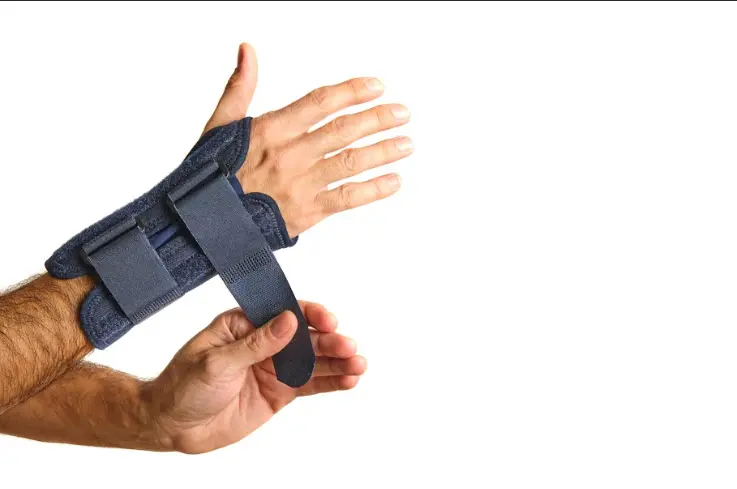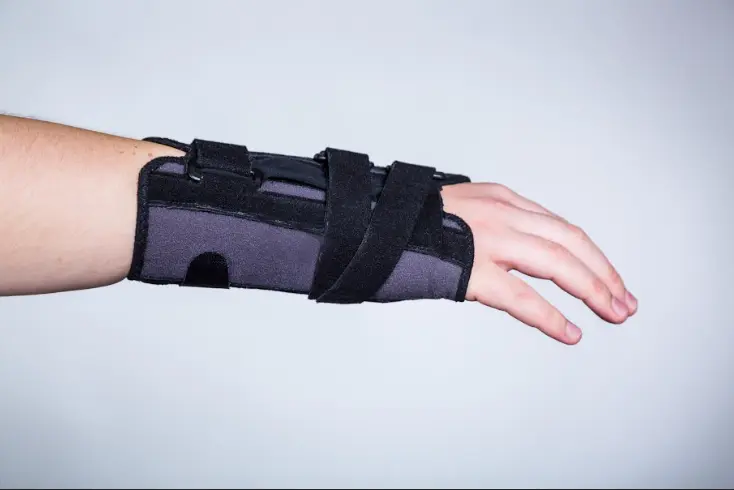
A continuous pain in your wrist with a numb feeling, particularly when working, doing small tasks, or trying to sleep. It may indicate that you have carpal tunnel syndrome. The pain can frustrate and create an unbearable situation for you. Many people worry this means surgery or expensive treatment, but often, relief is possible without surgery through the right support device: a wrist splint or a wrist brace.
In this blog, we’ll explore
- What is a wrist splint
- How Wrist splint helps to treat carpal tunnel syndrome
- The difference between a wrist brace and a wrist splint
- When and how to wear a wrist splint for best results
- Expert tips on choosing the best wrist splint for your condition
What is a Wrist Splint?
A wrist splint is an external orthotic device used to keep your wrist in a neutral position. It effectively helps to reduce pressure on the median nerve that passes through the carpal tunnel in your wrist. The splint immobilizes the joint, reduces strain and enables inflamed tissues to relax and heal.
You can find various types of Wrist splints, ranging from soft, flexible options to firm, medical-grade braces.
Types of Wrist Splints and their functions
The different types of wrist splints have features suitable for unique conditions:
1. Resting or Static Wrist Splint
- It keeps the wrist immobile in neutral position.
- Wear it at night. Ideal for for carpal tunnel syndrome, arthritis, and to recover post-surgery.
- Offers strong support and has adjustable straps.
2. Cock-Up Wrist Splint
- Keeps the wrist in elevated position, relieves pressure on the median nerve.
- Works for carpal tunnel syndrome, wrist sprains, and repetitive strain injuries.
- Allows finger movement while stabilising the wrist.
3. Thumb Spica Splint
- Supports both the wrist and thumb.
- Suitable to get relief from thumb sprains and arthritis pain in the thumb joint.
- Limits thumb movement.
4. Dynamic Wrist Splint
- Controls movement and resistance to help muscle strengthening.
- Best for nerve injuries, post-stroke rehab, and tendon repairs.
- It has elastic or spring-loaded components for assisted motion.
5. Functional or Working Wrist Brace
- Provides moderate support. Allows movement for daily activities.
- Relieves mild wrist pain. Suitable to wear during repetitive tasks like typing or lifting.
- It is lightweight and breathable without rigid stays.
6. Custom-Made Splints
- Custom-made for the individual’s hand/wrist anatomy and condition.
- Works for fractures, post-surgical recovery, and long-term wear.
When Should You Wear a Wrist Splint?
You should wear a wrist splint if you have:
- Carpal tunnel syndrome– preferably at night to prevent wrist bending during sleep.
- Wrist drop or nerve palsy.
- Post-surgical recovery.
- Wrist swelling due to repetitive strain.
- Strain injuries
- Tendonitis
What is the Use Wrist Brace for Wrist Pain
You can use a wrist brace, if the pain is mild and occurs during activity.Wearing a wrist brace offers good movement and supports your wrist during typing or housework.
What Does a Wrist Brace Do?
- Limits wrist movement to prevent strain
- Provides support to tendons and ligaments during healing
- Lessens inflammation and pressure on affected areas
- Promotes wrist alignment during tasks
- Reduces worsening strain or overuse
- Works for tendinitis, mild carpal tunnel syndrome, sprains, and arthritis
- Braces are breathable and can be worn during work
When to Use a Wrist Brace
- During typing or computer work
- While lifting objects or using tools
- During persistent wrist pain during activity
- While recovering from mild injuries or flare-ups
What is the Difference Between a Wrist Brace and a Wrist Splint?
While the terms are often used interchangeably, they serve slightly different purposes:
| Device | Purpose | Ideal Use |
|---|---|---|
| Wrist Splint | Keeps wrist in neutral position, immobilises joint, reduces nerve pressure. | Carpal tunnel syndrome, nerve injuries, arthritis, recovery after surgery. |
| Wrist Brace | Provides moderate support with some flexibility, allows movement during activity. | Mild wrist pain, strain prevention during work or sports. |
How Does a Wrist Splint Help Carpal Tunnel Syndrome?

A wrist splint is one of the most effective non-surgical ways to manage carpal tunnel syndrome. It keeps your wrist in a neutral (straight) position, reducing pressure on the median nerve and helping relieve pain, numbness, and tingling.
Benefits of a Wrist Splint for Carpal Tunnel:
- Keeps wrist neutral to avoid nerve compression.
- Lessens numbness and tingling.
- Prevents condition from worsening.
- Aids restful sleep by reducing night-time symptoms.
- Supports healing without surgery.
How to Wear a Wrist Splint for Carpal Tunnel
Check out these tips on how to wear your wrist splint for your carpal tunnel problem:
- Wear at night.
- It must be comfortable and not tight.
- Do not use the splint all day.
- Clean the brace regularly.
- Get a new wrist splint if it wears out.
Quick Tip: A cock-up wrist splint is often recommended because it supports the wrist while allowing finger movement, making it more comfortable for night use.
How To Choose the Right Wrist Splint?
Consider the following:
| Feature | Why It Matters |
| Fitting & Comfort | Adjustable straps and comfortable fabric |
| Support Type | Rigid braces offer better immobilisation; soft splints may be better for daytime use |
| Right vs. Left Hand | Some splints are hand-specific, others are reversible |
| Day or Night Use | Night splints tend to be more structured for resting support |
How to Choose the Best Wrist Splint Support for Pain
| Feature | Why It Matters |
| Fit & Comfort | Prevents chafing or discomfort; adjustable straps ensure a better, secure fit |
| Support Type | Strong splints immobilize the wrist; soft braces allow light, flexible support |
| Hand Specificity | Ensures proper fit for left or right wrist, or reversible for both |
| Usage Time | Night-time models provide rest; daytime models offer mobility with support |
What Is a Wrist Drop Splint? Is It the Same as a Wrist Splint?
A wrist drop splint is a specialised support device used to treat wrist drop, a condition where the wrist and fingers cannot straighten due to radial nerve damage. It holds the wrist in a slightly extended position, preventing the hand from drooping and aiding function during recovery.
A wrist splint is a broader term for any device that supports or immobilises the wrist for conditions like sprains, fractures, or carpal tunnel syndrome.
Key difference:
- All wrist drop splints are wrist splints, but not all wrist splints are designed for wrist drop. A wrist drop splint has features specifically for this condition.
Key Takeaway
- Wrist splints provide steady and robust support and are ideal to immobilise and heal, during recovery.
- Wrist braces offer flexible and regular support.
- The right fit, proper use, and expert guidance matter.
Frequently Asked Questions
The time depends on specific conditions. You can wear a splint at night for several weeks for carpal tunnel syndrome and wear it during the day and night for during recovery from injuries.
A wrist splint should not be too tight. The splint should offer support without cutting off circulation or causing numbness and your fingers should move freely.
It depends on your condition, but for carpal tunnel, consistent nighttime use for several weeks often brings relief.
Final Thoughts
Why limit your life to treatable conditions like carpal tunnel syndrome or wrist strain? You can be your active self by wearing a wrist splint or a wrist brace while recovering from injury or managing pain from repetitive tasks. Finding and wearing the right wrist splint or brace can change your day-to-day life.



